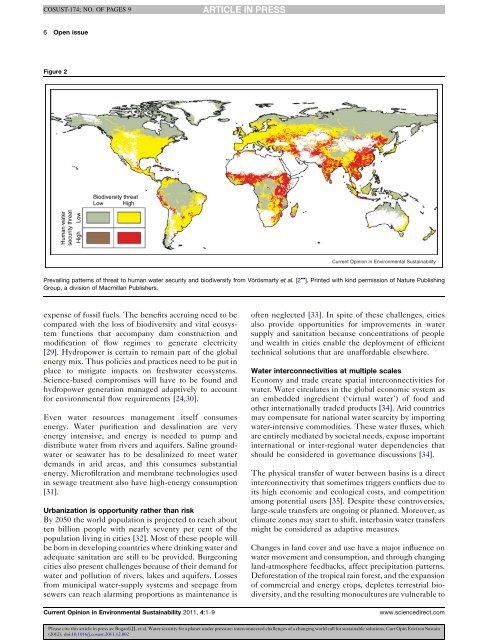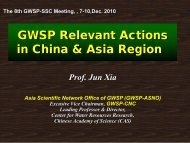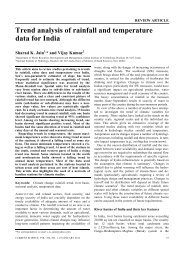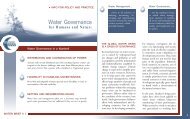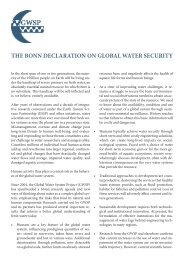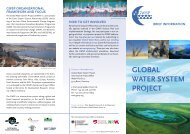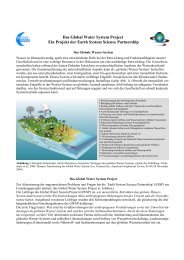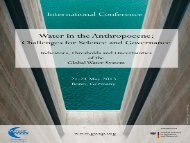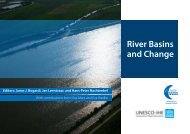Water security for a planet under pressure: interconnected ... - GWSP
Water security for a planet under pressure: interconnected ... - GWSP
Water security for a planet under pressure: interconnected ... - GWSP
Create successful ePaper yourself
Turn your PDF publications into a flip-book with our unique Google optimized e-Paper software.
COSUST-174; NO. OF PAGES 9<br />
6 Open issue<br />
Figure 2<br />
Biodiversity threat<br />
Low High<br />
Human water<br />
<strong>security</strong> threat<br />
High<br />
Low<br />
Current Opinion in Environmental Sustainability<br />
Prevailing patterns of threat to human water <strong>security</strong> and biodiversity from Vörösmarty et al. [2 ]. Printed with kind permission of Nature Publishing<br />
Group, a division of Macmillan Publishers.<br />
expense of fossil fuels. The benefits accruing need to be<br />
compared with the loss of biodiversity and vital ecosystem<br />
functions that accompany dam construction and<br />
modification of flow regimes to generate electricity<br />
[29]. Hydropower is certain to remain part of the global<br />
energy mix. Thus policies and practices need to be put in<br />
place to mitigate impacts on freshwater ecosystems.<br />
Science-based compromises will have to be found and<br />
hydropower generation managed adaptively to account<br />
<strong>for</strong> environmental flow requirements [24,30].<br />
Even water resources management itself consumes<br />
energy. <strong>Water</strong> purification and desalination are very<br />
energy intensive, and energy is needed to pump and<br />
distribute water from rivers and aquifers. Saline groundwater<br />
or seawater has to be desalinized to meet water<br />
demands in arid areas, and this consumes substantial<br />
energy. Microfiltration and membrane technologies used<br />
in sewage treatment also have high-energy consumption<br />
[31].<br />
Urbanization is opportunity rather than risk<br />
By 2050 the world population is projected to reach about<br />
ten billion people with nearly seventy per cent of the<br />
population living in cities [32]. Most of these people will<br />
be born in developing countries where drinking water and<br />
adequate sanitation are still to be provided. Burgeoning<br />
cities also present challenges because of their demand <strong>for</strong><br />
water and pollution of rivers, lakes and aquifers. Losses<br />
from municipal water-supply systems and seepage from<br />
sewers can reach alarming proportions as maintenance is<br />
often neglected [33]. In spite of these challenges, cities<br />
also provide opportunities <strong>for</strong> improvements in water<br />
supply and sanitation because concentrations of people<br />
and wealth in cities enable the deployment of efficient<br />
technical solutions that are unaf<strong>for</strong>dable elsewhere.<br />
<strong>Water</strong> interconnectivities at multiple scales<br />
Economy and trade create spatial interconnectivities <strong>for</strong><br />
water. <strong>Water</strong> circulates in the global economic system as<br />
an embedded ingredient (‘virtual water’) of food and<br />
other internationally traded products [34]. Arid countries<br />
may compensate <strong>for</strong> national water scarcity by importing<br />
water-intensive commodities. These water fluxes, which<br />
are entirely mediated by societal needs, expose important<br />
international or inter-regional water dependencies that<br />
should be considered in governance discussions [34].<br />
The physical transfer of water between basins is a direct<br />
interconnectivity that sometimes triggers conflicts due to<br />
its high economic and ecological costs, and competition<br />
among potential users [35]. Despite these controversies,<br />
large-scale transfers are ongoing or planned. Moreover, as<br />
climate zones may start to shift, interbasin water transfers<br />
might be considered as adaptive measures.<br />
Changes in land cover and use have a major influence on<br />
water movement and consumption, and through changing<br />
land-atmosphere feedbacks, affect precipitation patterns.<br />
De<strong>for</strong>estation of the tropical rain <strong>for</strong>est, and the expansion<br />
of commercial and energy crops, depletes terrestrial biodiversity,<br />
and the resulting monocultures are vulnerable to<br />
Current Opinion in Environmental Sustainability 2011, 4:1–9 www.sciencedirect.com<br />
Please cite this article in press as: Bogardi JJ, et al. <strong>Water</strong> <strong>security</strong> <strong>for</strong> a <strong>planet</strong> <strong>under</strong> <strong>pressure</strong>: <strong>interconnected</strong> challenges of a changing world call <strong>for</strong> sustainable solutions, Curr Opin Environ Sustain<br />
(2012), doi:10.1016/j.cosust.2011.12.002


